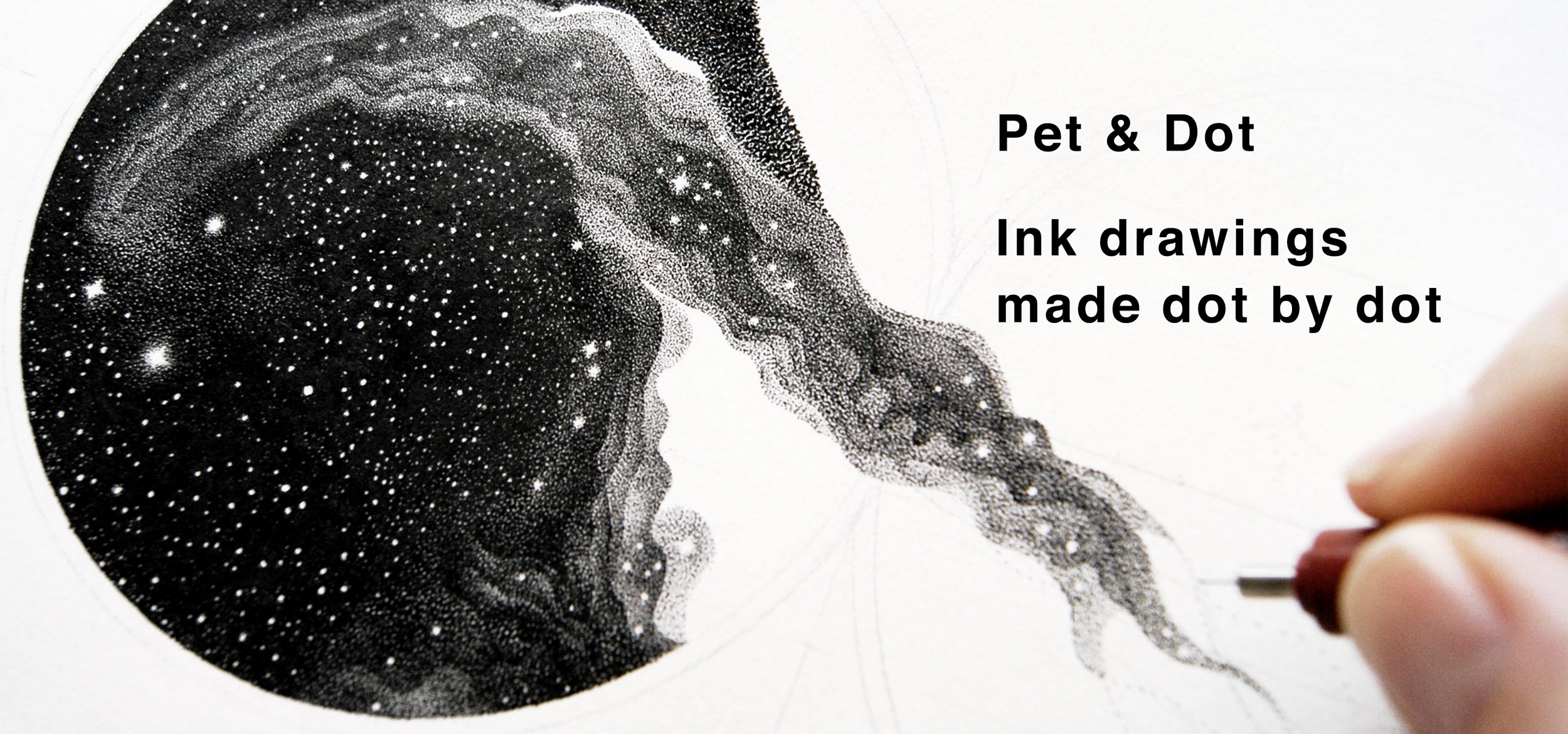Hello👋️
I’m Petra.
UX & UI
Designer
︎︎
- 13 years of experience in graphic, UX, and product design
- 8 years in fintech, leading product and UX design at November First
- Designed features across onboarding, payments, KYC, and risk monitoring
- Passionate about clear, human-centered design that simplifies complexity

My Experience at November First
︎︎
About November First
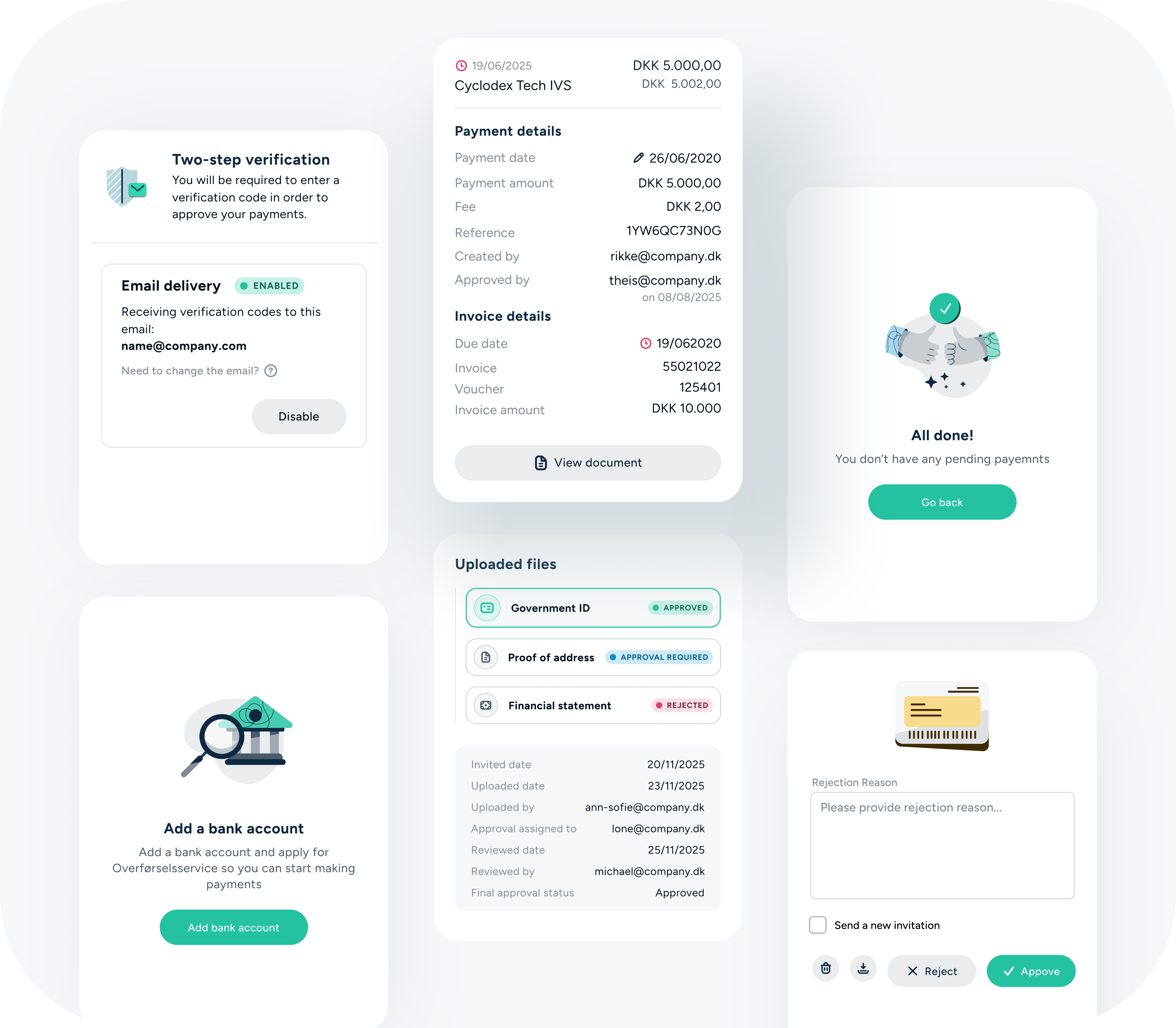
🧙♀️ My role
Over eight years, my role grew from website and graphic design into a central position shaping product design and key features. I contributed to roadmaps, feature prioritization, and cross-functional planning. In a small team, my responsibilities included:
Over eight years, my role grew from website and graphic design into a central position shaping product design and key features. I contributed to roadmaps, feature prioritization, and cross-functional planning. In a small team, my responsibilities included:
- Established and maintained a coherent visual identity and unified UI design system
- Designed key features for customer-facing platforms and internal tools, including onboarding, payments, and compliance workflows
- Mapped user journeys and created flowcharts, wireframes, and prototypes to guide feature design
- Wrote detailed documentation for existing and new features to ensure clarity and alignment across the team
- Troubleshot issues and collaborated with development to resolve bugs
- Acted as a bridge between operations and development, translating user and business needs into actionable product improvement
- Influenced product strategy, feature prioritization, and iterative improvements across the platform
🎨 Key design areas
🗂️ Selected Case Studies
Below are several projects I particularly enjoyed working on, where I contributed to both strategic design decisions and hands-on execution across product and visual design.
- Payment platform (including white-label partner interfaces)
- Payments for partners via API (e.g., SmartPay with e-conomic)
- Internal admin portal for customer management, payment management, due diligence, and risk monitoring
- Company-wide visual style — website, presentations, promotional materials, and unified UI systems used across portals
🗂️ Selected Case Studies
Below are several projects I particularly enjoyed working on, where I contributed to both strategic design decisions and hands-on execution across product and visual design.


Case Study 1:
Smart Pay (N1 + e-conomic)
Area: Partner Integration via API
📖 Overview
Smart Pay is a payment solution developed in collaboration between November First and the accounting system e-conomic. The goal was to enable e-conomic users to pay invoices directly from their accounting system with just a few clicks. Payments were initiated via API integration, where e-conomic managed the invoice and document interface, while November First handled secure payment approval and execution.
The collaboration extended beyond payments to include onboarding, email communication, and other user touchpoints, ensuring a consistent, compliant, and integrated experience across both platforms.
Smart Pay (N1 + e-conomic)
Area: Partner Integration via API
📖 Overview
Smart Pay is a payment solution developed in collaboration between November First and the accounting system e-conomic. The goal was to enable e-conomic users to pay invoices directly from their accounting system with just a few clicks. Payments were initiated via API integration, where e-conomic managed the invoice and document interface, while November First handled secure payment approval and execution.
The collaboration extended beyond payments to include onboarding, email communication, and other user touchpoints, ensuring a consistent, compliant, and integrated experience across both platforms.
🤔 Problem
- The existing integration already allowed invoice data to be fetched via API and processed through a November First UI embedded within e-conomic.
- While functional, the setup wasn’t scalable — e-conomic required a fully native payment solution to reach a wider customer base.
- November First’s role shifted to providing seamless payment approval, requiring a clear separation of responsibilities between both systems.
- The experience needed to remain consistent and trustworthy across the two platforms.
- The new integration also had to support shared onboarding and communication flows between both brands without confusing end users.
 Original Integration embedded within e-conomic.
Original Integration embedded within e-conomic. Approval flow overview: Smart Pay vs. native payment approval.
Approval flow overview: Smart Pay vs. native payment approval.🔎 Research & Insights
As preparation for designing the joint flow, we gathered and synthesized insights from both November First’s and e-conomic’s teams, combining product knowledge, support experience, and industry best practices.
Key considerations included:
As preparation for designing the joint flow, we gathered and synthesized insights from both November First’s and e-conomic’s teams, combining product knowledge, support experience, and industry best practices.
Key considerations included:
- Understanding the essential compliance steps (CDD/KYC) required in each system.
- Identifying overlapping or redundant processes across the two platforms.
- Reviewing best practices for onboarding and payment flows to ensure clarity, trust, and efficiency.
- Aligning messaging, touchpoints, and visual cues across platforms to create a consistent, reassuring experience.
🧠 Design Process
Building on those insights, the design process focused on creating a unified, intuitive flow connecting e-conomic’s interface with November First’s payment environment. Collaboration and iteration were key throughout.
Main steps included:
Building on those insights, the design process focused on creating a unified, intuitive flow connecting e-conomic’s interface with November First’s payment environment. Collaboration and iteration were key throughout.
Main steps included:
- Mapping shared onboarding journeys to define smooth transitions between the two platforms.
- Joint workshops and design reviews to align flows, patterns, and compliance messaging.
- Prototyping and testing different approaches for onboarding, authentication, approval, and redirection.
- Establishing shared visual and UX guidelines to keep the experience cohesive while preserving November First’s trust cues.
 Preview of a white-label UI library for Smart Pay.
Preview of a white-label UI library for Smart Pay.
Confirmation step after being redirected to November First UI.
🔮 Final Design & Iterations
Over several years, the flow evolved through continuous collaboration with e-conomic’s product and support teams. I participated in regular product meetings and cross-company workshops to ensure full alignment between both teams.
Key areas of focus included:
This iterative and co-creative approach resulted in a more seamless, compliant, and scalable integration — establishing a strong foundation for future collaborative partnerships.
Over several years, the flow evolved through continuous collaboration with e-conomic’s product and support teams. I participated in regular product meetings and cross-company workshops to ensure full alignment between both teams.
Key areas of focus included:
- Onboarding flow enhancements
- Bank account and user management
- Email communication and customer notifications
- Feature prioritization that balanced user needs with scalability goals
This iterative and co-creative approach resulted in a more seamless, compliant, and scalable integration — establishing a strong foundation for future collaborative partnerships.


Case Study 2:
Two-Factor Authentication
Area: Customer-Facing Products
📖 Overview
To strengthen payment security, we introduced two-factor authentication (2FA) as an additional safeguard for customers approving transactions. This feature was a critical step in aligning our product with industry security standards while maintaining a smooth and trustworthy user experience.
🤔 Problem
Two-Factor Authentication
Area: Customer-Facing Products
📖 Overview
To strengthen payment security, we introduced two-factor authentication (2FA) as an additional safeguard for customers approving transactions. This feature was a critical step in aligning our product with industry security standards while maintaining a smooth and trustworthy user experience.
🤔 Problem
- Payments could be authorized using only a password, creating a high security risk.
- The product lacked alignment with industry standards for financial transactions.
- The challenge was to add security without creating unnecessary friction in the payment process

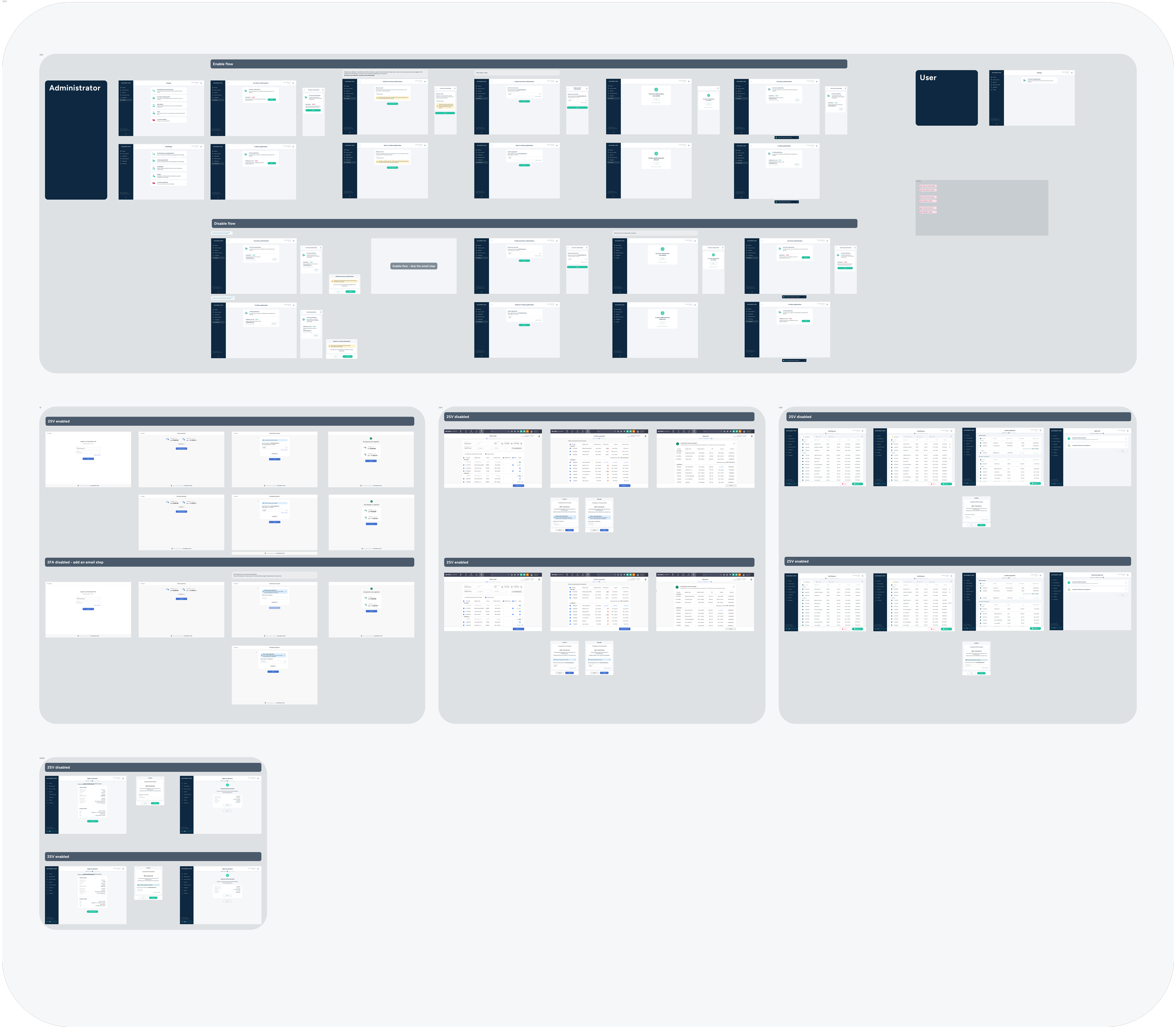
High-level flow mapping showing areas impacted by 2FA
🔎 Research & Insights
The project required a balance of technical feasibility and user experience considerations. From a design and product perspective, I mapped out the user journeys where additional authentication was essential.
The project required a balance of technical feasibility and user experience considerations. From a design and product perspective, I mapped out the user journeys where additional authentication was essential.
- Initial scope: 2FA was introduced for payment approvals, the most critical security action.
- Future flexibility: The solution was designed to expand and cover other sensitive areas of the portal, such as logging in and changing critical settings
🧠 Design Process
The design process focused on integrating 2FA seamlessly into the payment workflow while minimizing friction for users.
Key steps included:
The design process focused on integrating 2FA seamlessly into the payment workflow while minimizing friction for users.
Key steps included:
- Mapping affected flows: Identified all areas of the product impacted by the change to ensure comprehensive coverage.
- Flow diagrams and screen mapping: Documented how the 2FA step would interact with existing screens, ensuring alignment between the product and development teams.
- Prototyping and user testing: Created prototypes to explore different ways of presenting the authentication step, and tested them with several users.
- Future-proofing: Designed the 2FA system to be extensible, allowing expansion to other sensitive actions such as login and critical settings changes.
 Flowchart illustrating the setup and payment approval process with 2FA
Flowchart illustrating the setup and payment approval process with 2FA
Payment confirmation step protected by 2FA.
🔮 Final Design
The final implementation of 2FA strengthened security while keeping the user experience familiar and straightforward:
The final implementation of 2FA strengthened security while keeping the user experience familiar and straightforward:
- From the user’s perspective, the flow change was minimal — in most cases, the password step was replaced with a one-time code for authentication.
- Simple and clear messaging encouraged users to enable the feature, ensuring awareness and adoption without friction.
- Visual and interaction patterns were consistent with the existing portal, maintaining a cohesive experience.
- The feature remained flexible and scalable, designed to extend to other sensitive actions such as login or critical account changes.

Case Study 3:
Due Diligence Document & Data Collection
Area: Customer-Facing Product & Internal Admin Portal
📖 Overview:
The project focused on designing a comprehensive management tool for regulatory due diligence to ensure compliance with anti-money laundering (AML) standards and effective risk management. The goal was to streamline the collection of customer information and supporting documentation, reduce manual workload, and improve the experience for both customers and internal teams.
This was part of a long-term, ongoing initiative spanning the entire compliance ecosystem and most areas of operations, requiring close collaboration across multiple teams and processes to create a cohesive, scalable solution.

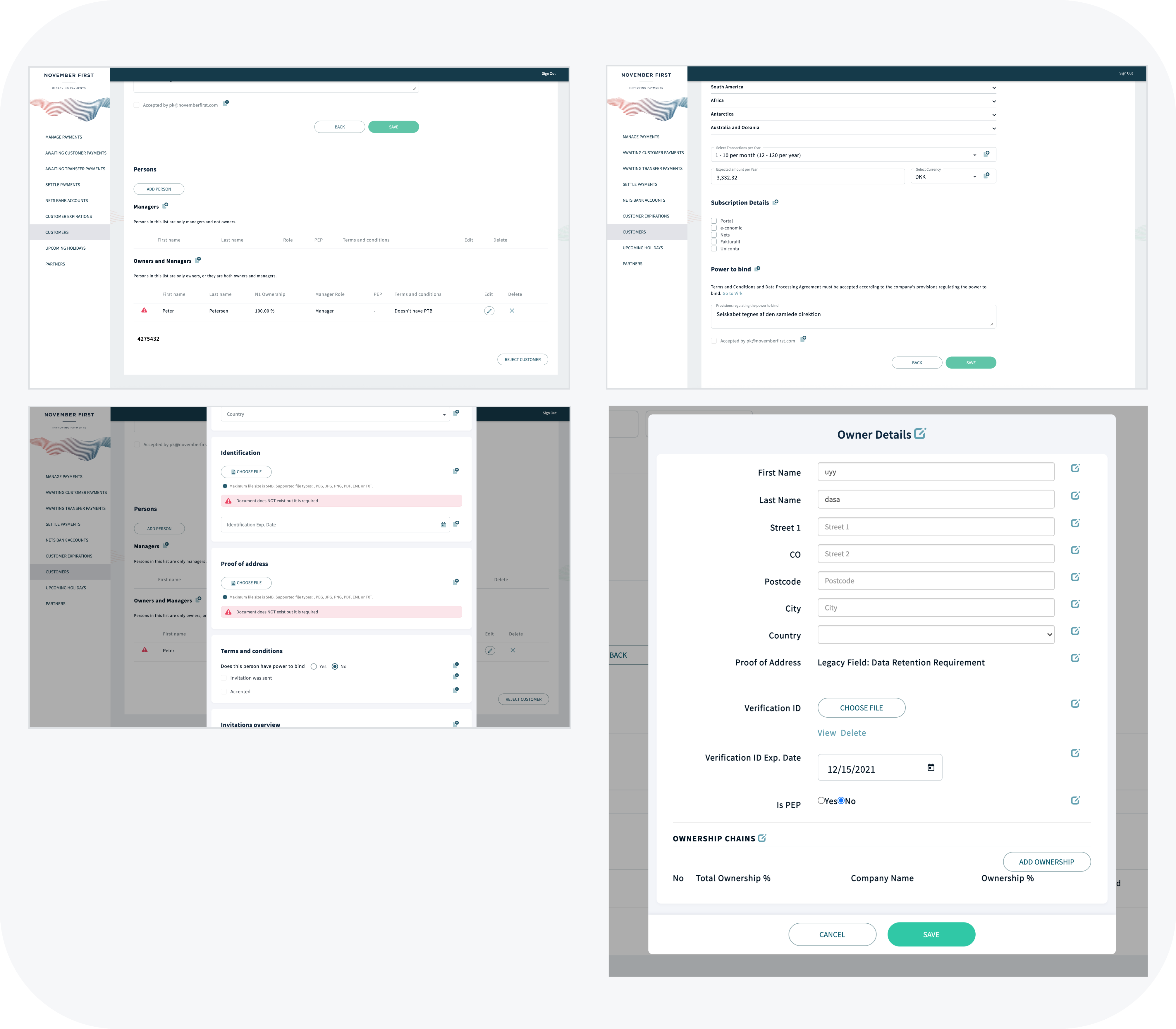
Original admin portal — initial design before introducing new tools for customers, due diligence data and document management.
🤔 Problem
- During initial onboarding, only the account creator could upload identification documents, even though multiple authorized stakeholders often needed to provide documentation.
- There were no tools to support information collection during either initial or ongoing due diligence.
- Teams relied on notes in the admin portal, external systems, emails, and phone calls to request and store documentation.
- Ongoing due diligence lacked a centralized management tool, forcing teams to use multiple external systems and resulting in a fragmented overview.
- Processes were extremely manual, resource-intensive, and created friction for customers during onboarding and compliance checks.
- As a result, the system was not scalable and ill-equipped to support an expanding customer base.
🔎 Research & Insights
The first phase of the project focused on understanding existing workflows, identifying pain points, and uncovering opportunities to improve the collection of customer information and documentation.
The first phase of the project focused on understanding existing workflows, identifying pain points, and uncovering opportunities to improve the collection of customer information and documentation.
- Conducting extended team interviews across onboarding, compliance, and operations teams to gather feedback and uncover challenges.
-
Shadowing workflows to observe firsthand how teams requested, stored, and verified documentation.
-
Analyzing support tickets and recurring issues to identify common friction points for both customers and internal teams.
- Mapping dependencies across multiple systems to determine where integration and automation could deliver the most value.
- Due to the project’s scale and interconnectedness with other compliance initiatives, we divided it into phases: the first focused on improving document and information collection, with later phases planned to automate flows and integrate with other projects such as the risk model.
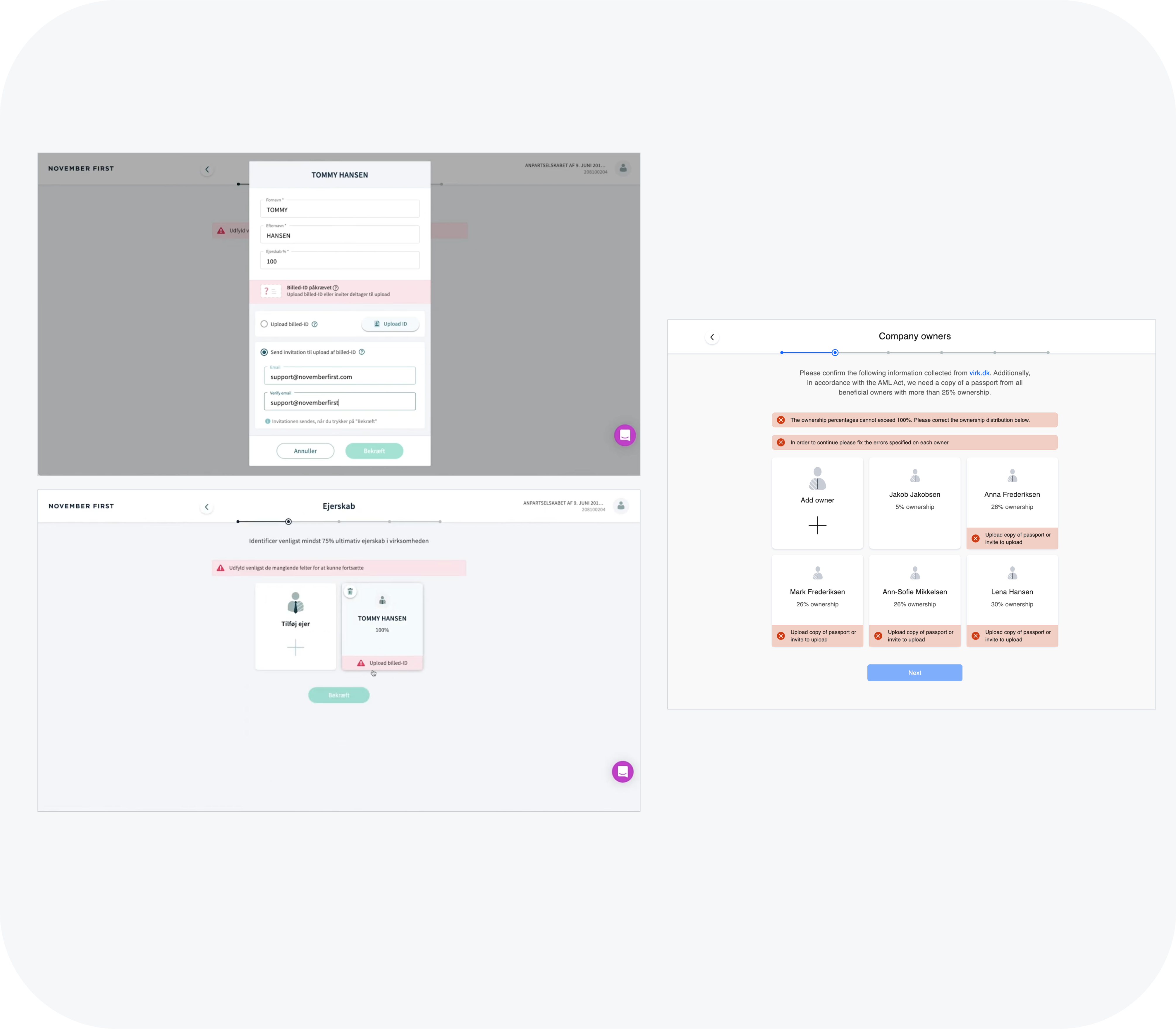 Original design of customer onboarding with limited features.
Original design of customer onboarding with limited features.
Flowchart illustrating the invitation and document approval flow
🧠 Design Process
The design process aimed to create a solution that addressed the immediate needs while laying the foundation for future integration and automation.
The design process aimed to create a solution that addressed the immediate needs while laying the foundation for future integration and automation.
- Workflow mapping: Created detailed charts of existing processes to identify bottlenecks and redundancies, then developed updated workflow diagrams for the proposed solution.
- Brainstorming sessions: Generating ideas and potential solutions for both admin and customer experiences.
- Wireframes and sketches: Produced low-fidelity screens to test interaction patterns and validate flow improvements before moving to higher-fidelity designs.
- Alignment across teams: Ensured that both compliance requirements and user experience considerations were addressed at every stage.
🔮 Final Results
Due to shifting priorities and, ultimately, the company’s closure, the project was not fully built. The goals for this phase included:
Admin Portal
Customer Portal
Due to shifting priorities and, ultimately, the company’s closure, the project was not fully built. The goals for this phase included:
Admin Portal
- Enable teams to define required information and documentation for each customer and send invitations to the relevant stakeholders.
- Provide a streamlined approval workflow for compliance teams to approve or reject submissions, with easy options to resend invitations when needed.
- Store all collected documents and information centrally, offering a comprehensive overview of due diligence status across customers.
Customer Portal
- Deliver a streamlined, intuitive flow for customers to submit documentation and provide requested information.
- Reduce friction during onboarding and compliance checks by allowing users to complete submissions directly in the system.
 Customer portal: Module for an invited person to provide information and documentation.
Customer portal: Module for an invited person to provide information and documentation. Customer portal: Module for an invited person to provide information and documentation.
Customer portal: Module for an invited person to provide information and documentation.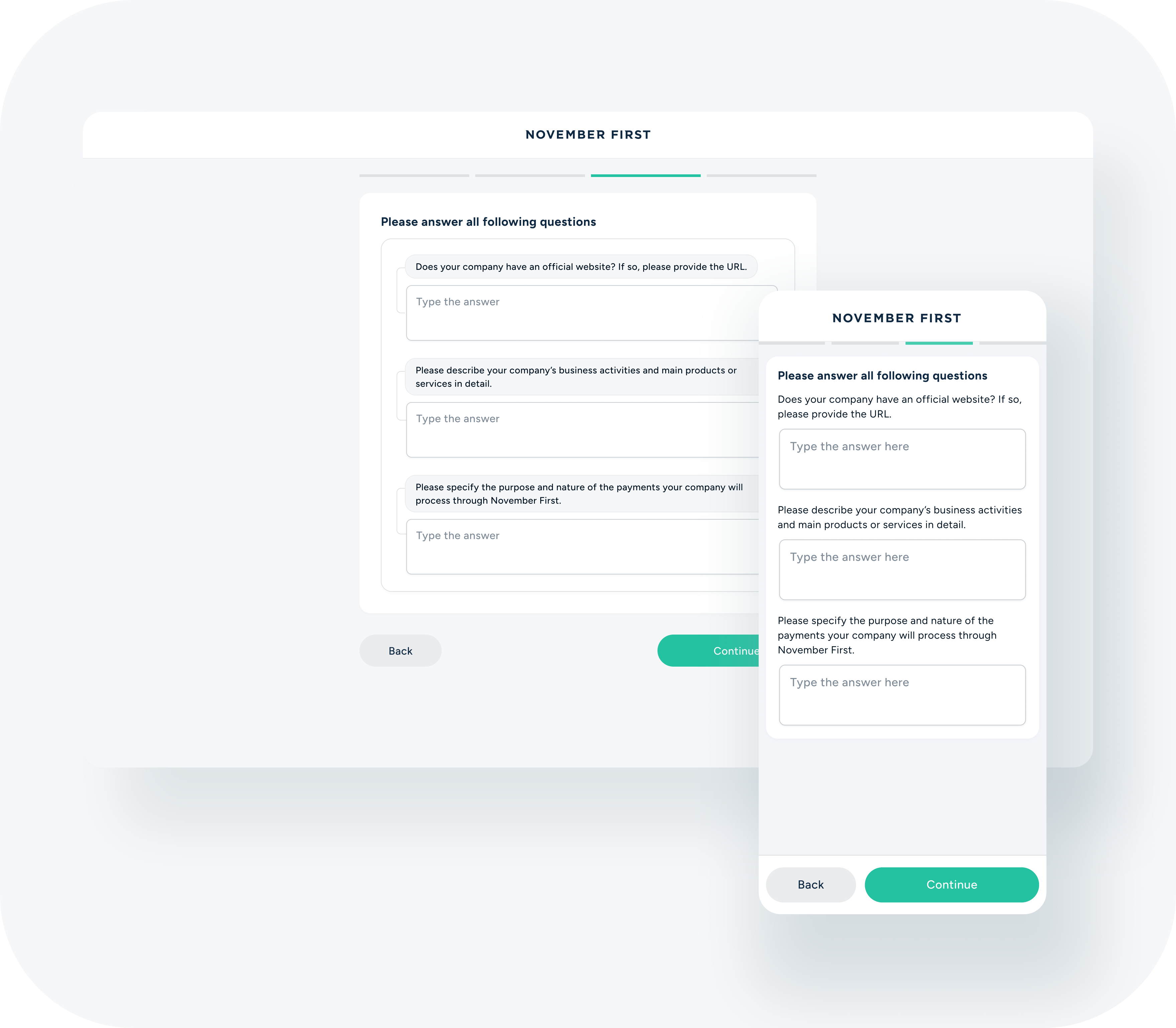
Customer portal: Module for an invited person to provide information and documentation.

Admin portal: Profile of a selected person.
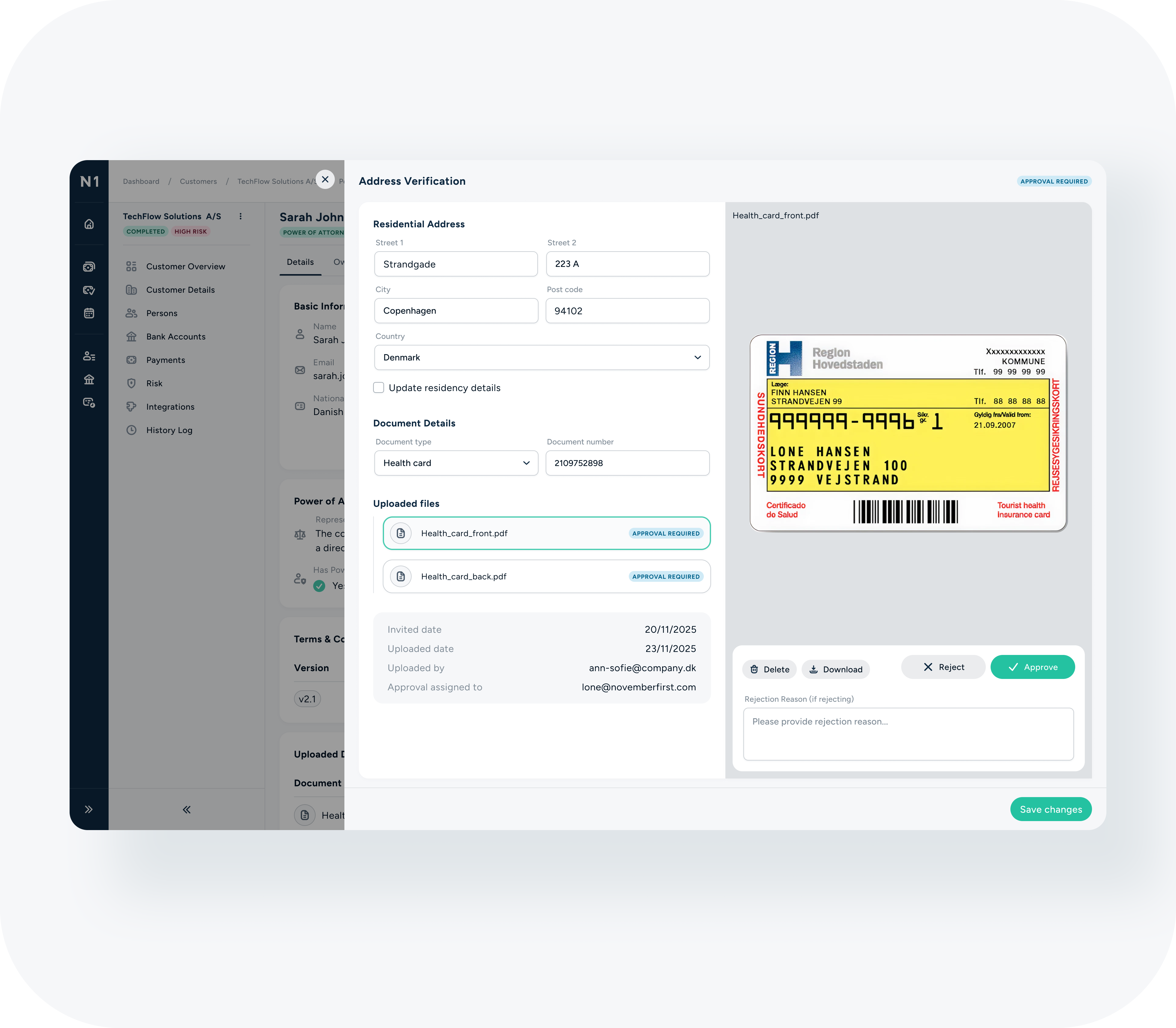
Admin portal: Module for managing and approving documents uploaded by invited users.
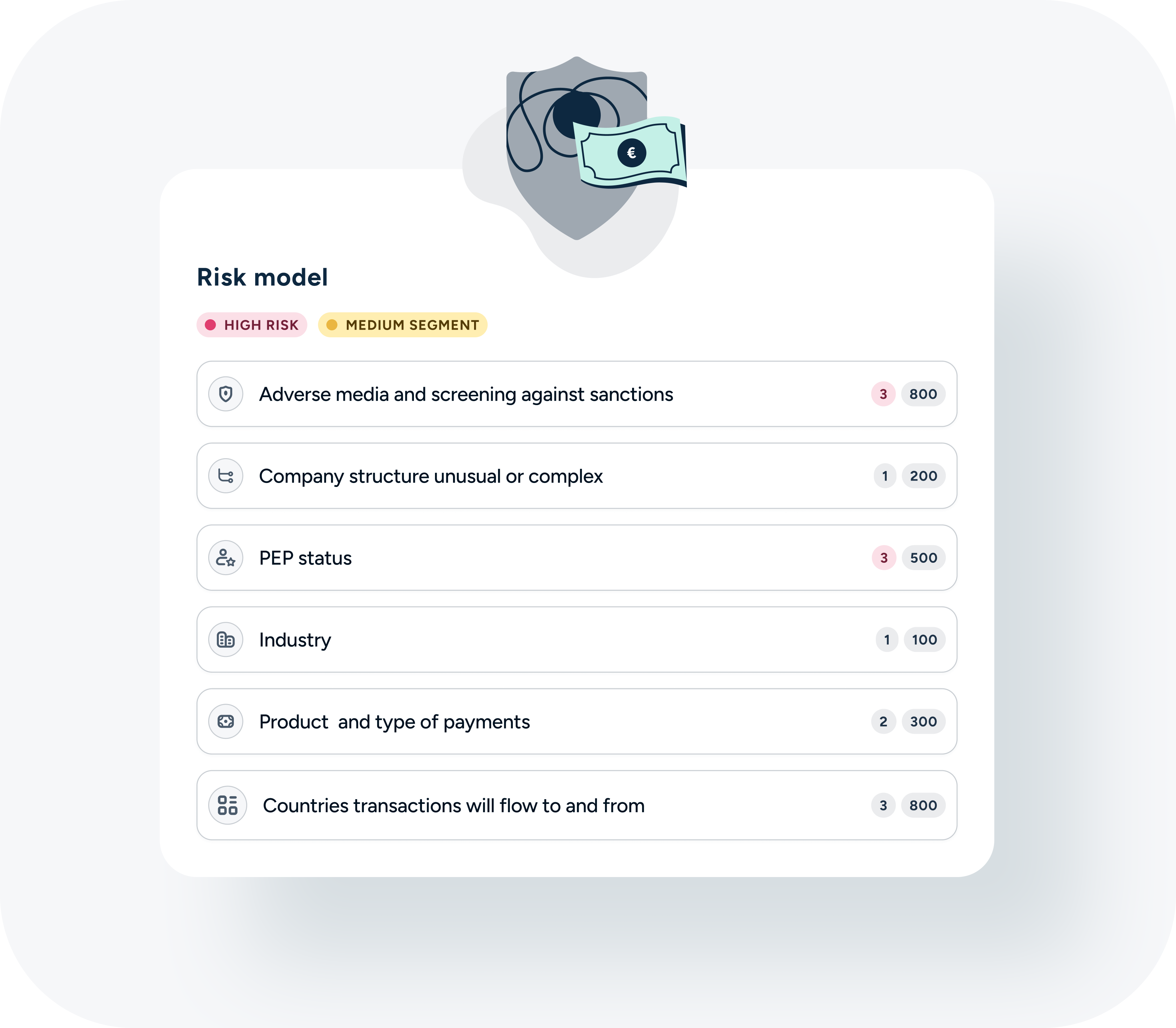
Case Study 4:
Risk Model
Area: Internal Admin Portal
📖 Overview
The Risk Model is a core component of the compliance framework, responsible for calculating customer risk scores based on regulatory requirements and internal policies. Closely connected to the Due Diligence Document & Data Collection project, it forms part of the broader compliance ecosystem.
The goal was to replace an outdated tool and centralize risk scoring within the internal admin portal, making the process reliable, user-friendly, and seamlessly integrated with other compliance areas such as CDD, ODD, and payment risk monitoring.
Risk Model
Area: Internal Admin Portal
📖 Overview
The Risk Model is a core component of the compliance framework, responsible for calculating customer risk scores based on regulatory requirements and internal policies. Closely connected to the Due Diligence Document & Data Collection project, it forms part of the broader compliance ecosystem.
The goal was to replace an outdated tool and centralize risk scoring within the internal admin portal, making the process reliable, user-friendly, and seamlessly integrated with other compliance areas such as CDD, ODD, and payment risk monitoring.
🤔 Problem
- The existing tool featured an outdated UI with incorrect questions and values, making it unusable under the updated due diligence framework.
- Compliance teams had to run Python scripts manually to calculate risk scores and paste results into shared spreadsheets.
- Collected data was stored in spreadsheets, disconnected from the main admin portal.
- The system lacked integration with other core areas, including CDD, ODD, and payment risk monitoring.
- As a result, workflows were manual, error-prone, and not scalable — creating inefficiencies and compliance risks.
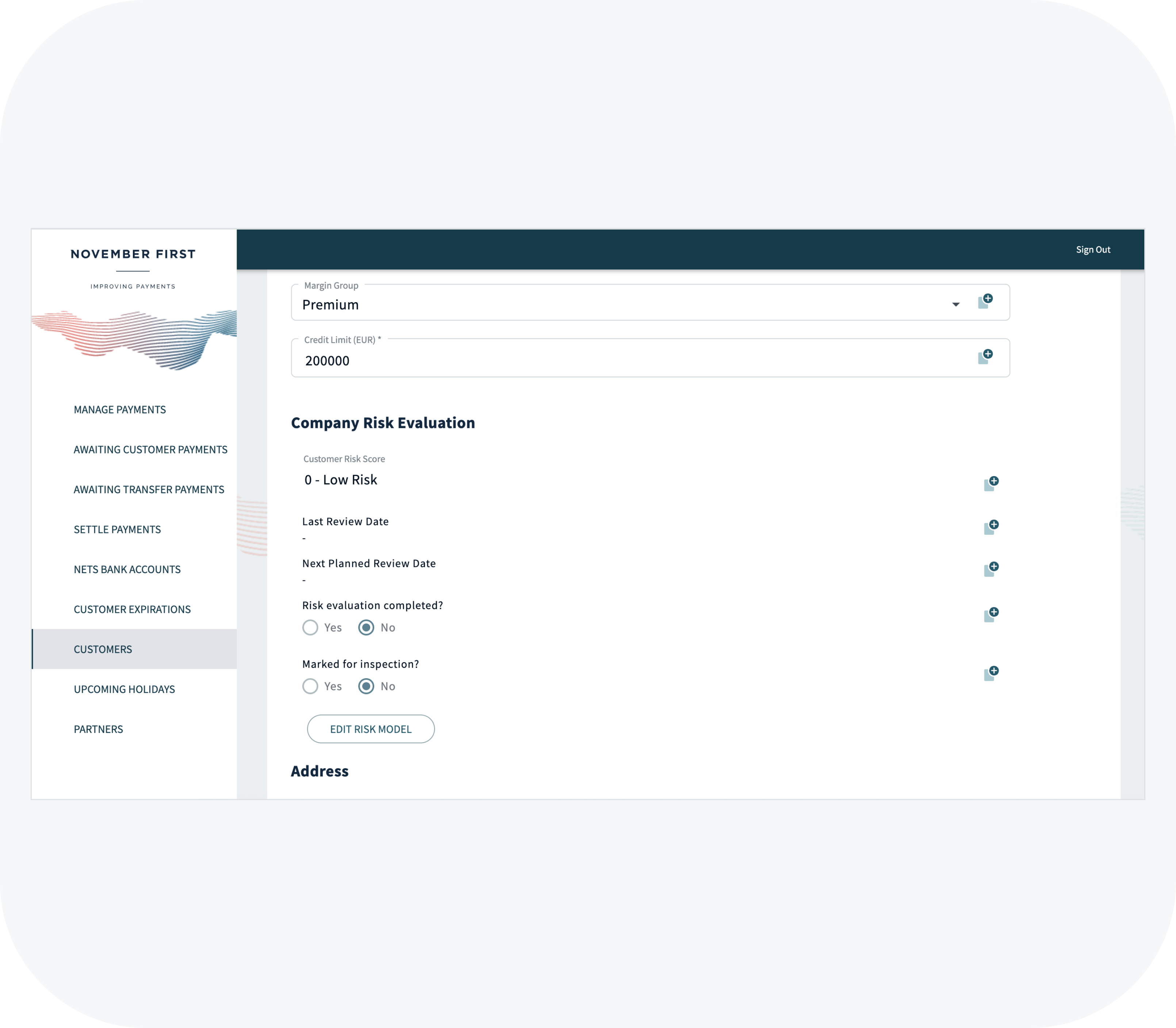
Original admin portal — risk model — before introducing new tools

Original admin portal — risk model — before introducing new tools
🔎 Research & Insights
To establish a foundation for the redesign, we focused on understanding both the regulatory and operational needs driving the risk assessment process.
To establish a foundation for the redesign, we focused on understanding both the regulatory and operational needs driving the risk assessment process.
- Conducting interviews and workflow observations with compliance and operations teams to understand how risk scoring was currently handled and where the main inefficiencies occurred.
- Collaborating closely with stakeholders to align on regulatory requirements and their practical implications for daily workflows.
- Mapping relationships between the Risk Model and other compliance tools to define clear integration points.
- Given the scale and complexity of the compliance ecosystem, the project was divided into phases: the first focused on displaying risk scores and key values within the admin portal, while future phases aimed to integrate with due diligence and payment monitoring tools.
🧠 Design Process
The design process focused on translating complex risk logic into a transparent, reliable, and easy-to-use interface for internal teams.
The design process focused on translating complex risk logic into a transparent, reliable, and easy-to-use interface for internal teams.
- Workflow mapping: Created detailed flow charts outlining the existing risk model logic and its connections to other compliance areas.
- Documentation and data collection: Compiled comprehensive documentation of the desired logic and calculations, incorporating detailed input from the compliance team.
- Iterative feedback: Held multiple review sessions with stakeholders to validate clarity, accuracy, and regulatory alignment before moving into final design.

Flowchart illustrating research into how the risk model connects with other areas of compliance.
 New Risk Model design — enabling automated scoring and transparency.
New Risk Model design — enabling automated scoring and transparency.Final Design & Outcome
The final concept introduced a streamlined, user-friendly risk scoring interface built directly into the admin portal.
Although the project was not fully developed due to shifting priorities and the company’s closure, the completed design laid a strong foundation for a fully integrated risk management system.
The final concept introduced a streamlined, user-friendly risk scoring interface built directly into the admin portal.
- Dynamic question sets aligned with the new due diligence framework and automatically updated based on customer type and risk factors.
- Real-time visibility of the customer’s risk score and contributing factors, improving transparency for the compliance team.
- Centralized data structure, eliminating the need for spreadsheets and manual calculations.
- Designed for scalability, with planned integration into ongoing due diligence and payment risk monitoring tools.
Although the project was not fully developed due to shifting priorities and the company’s closure, the completed design laid a strong foundation for a fully integrated risk management system.
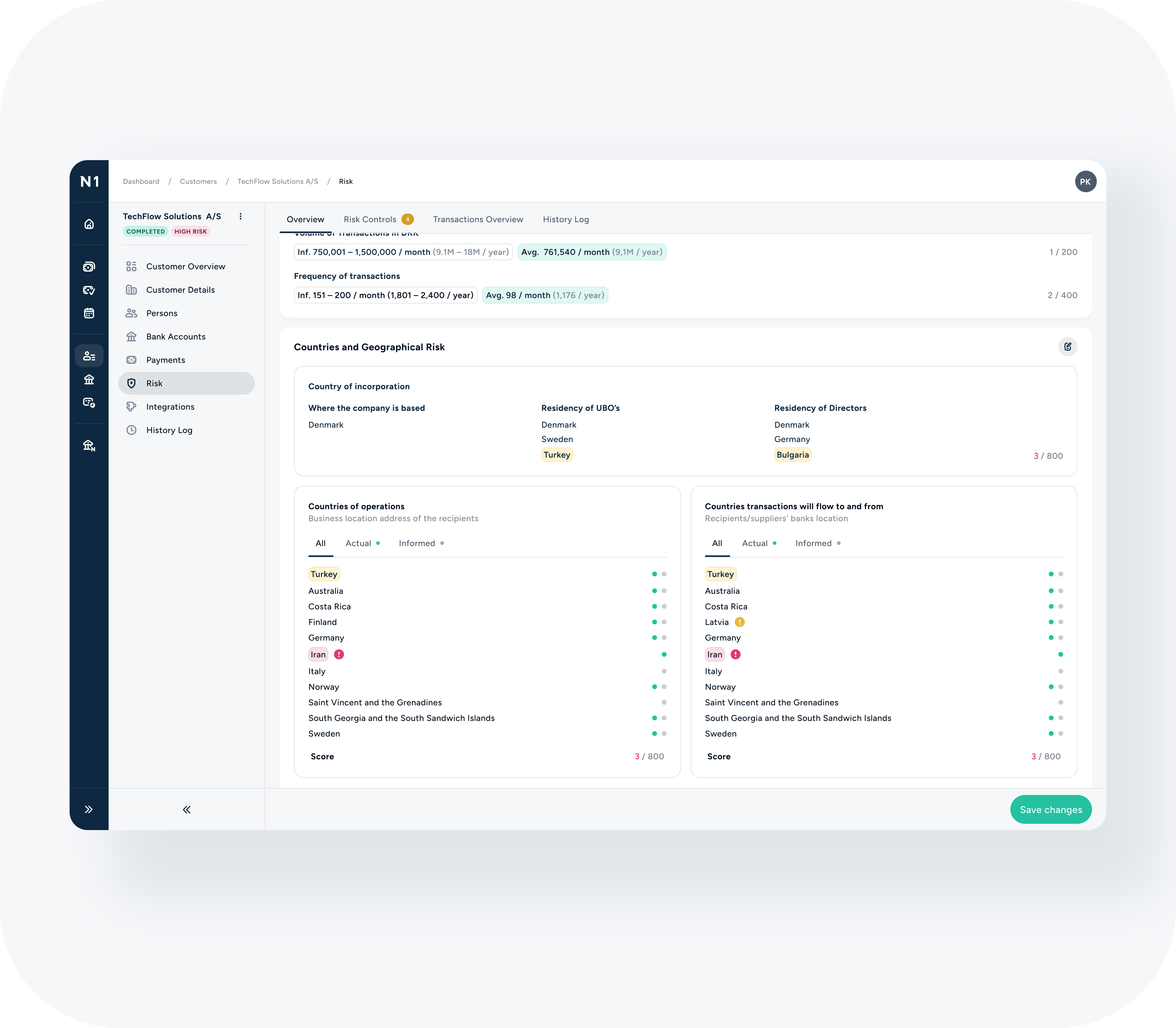
New Risk Model design — enabling automated scoring and transparency.
Weddii
UI & UX | Jan 2020 – Jun 2020︎︎
I joined the early-stage startup part-time to support the development of a digital wedding platform connecting couples and vendors. During my time there, I refined the visual direction and improved the overall user experience across both sides of the platform.My work included expanding the visual identity and UI design system, designing user flows and high-fidelity mockups for both the couple and vendor platforms, and supporting the website redesign to ensure a cohesive and consistent product experience.

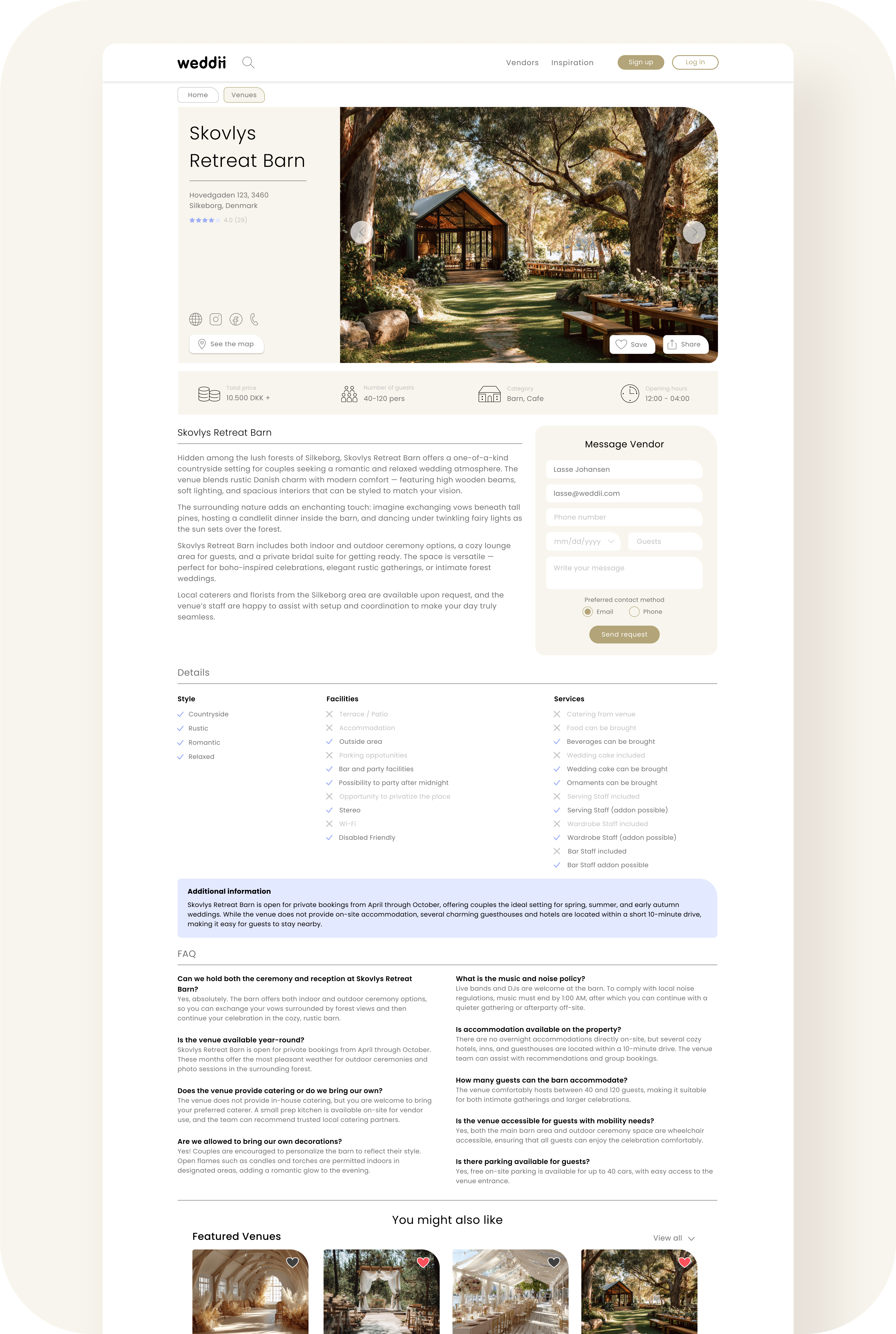

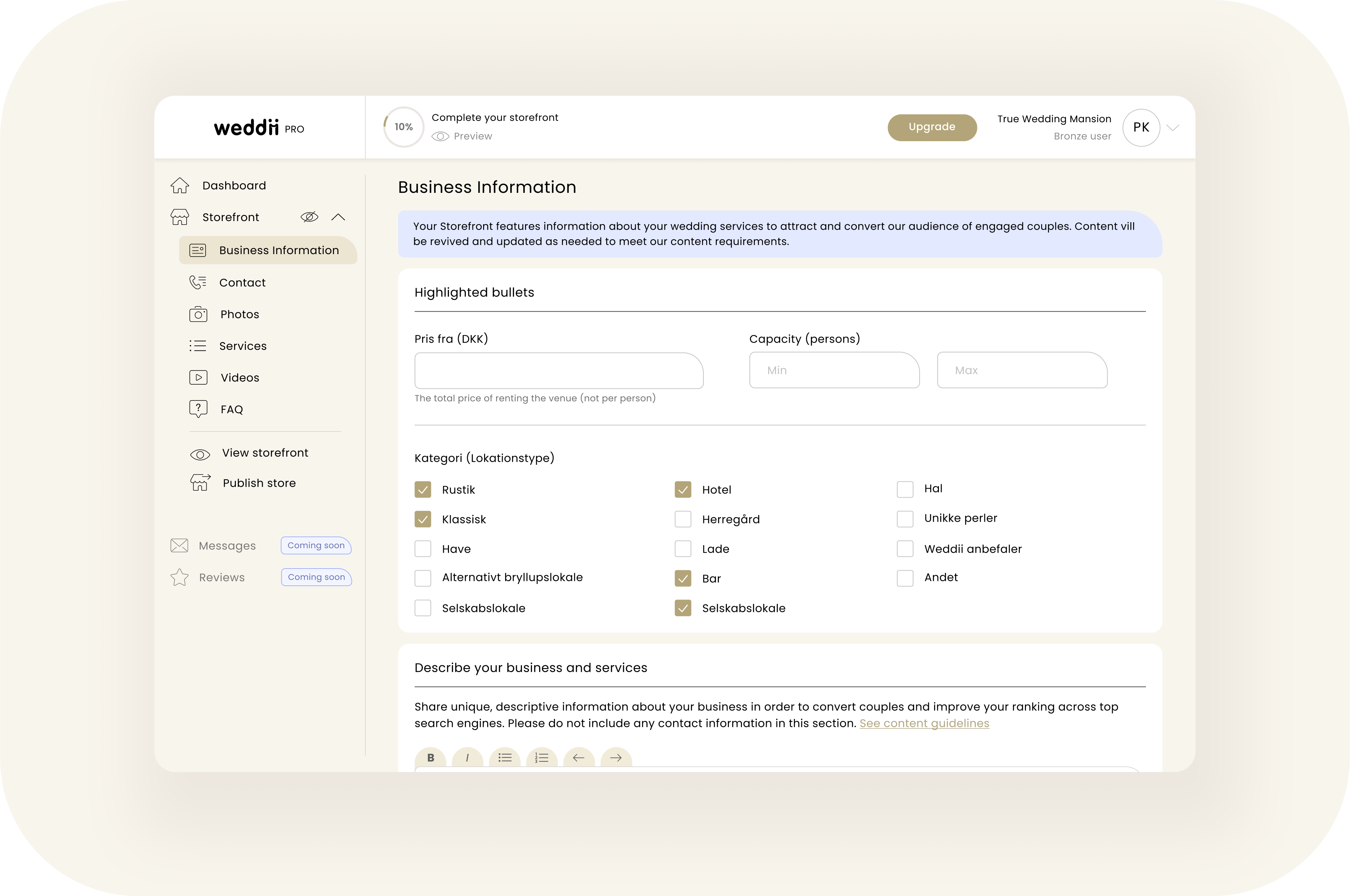

Mobile Game Alliance
Logo & Visual Identity | Jan 2018 – Nov 2018︎︎
As a part of young and exciting team in Mobile Game Alliance I led the creation of the company’s visual identity and brand presence.

Pet & Dot
Personal Art Project | 2015 – 2023︎︎
In 2015, I founded Pet & Dot, an independent artistic project focused on stippled ink drawings. I give a modern twist to traditional stippling, exploring themes such as gradients, geometric forms, and cosmic-inspired shapes.Beyond the creative work, I have managed every aspect of the brand — from developing visual identity and building an e-commerce webshop to creating and curating social media content (photography, video, and storytelling), growing a dedicated audience of 16k followers on Instagram and expanding presence across other platforms.
Follow my work:
Instagram @pet_and_dot
Tumblr

